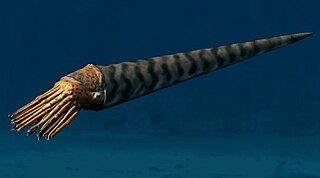Related Research Articles

The Nautilida constitute a large and diverse order of generally coiled nautiloid cephalopods that began in the mid Paleozoic and continues to the present with a single family, the Nautilidae which includes two genera, Nautilus and Allonautilus, with six species. All told, between 22 and 34 families and 165 to 184 genera have been recognised, making this the largest order of the subclass Nautiloidea.
Huronia is an actinocerid genus included in the Huroniidae along with Discoactinoceras and Huroniella,(Teichert 1964). Huronia is characterized by long siphuncle segments with the free part of the connecting rings only slightly inflated and by a narrow central canal and strongly curved radial canals located in the anterior part of each siphuncle segment

Plectronocerida is a primitive order from which subsequent cephalopod orders are ultimately derived.
Actinoceras is the principal and root genus of the Actinoceratidae, a major family in the Actinocerida, that lived during the Middle and Late Ordovician. It is an extinct genus of nautiloid cephalopod that thrived in the warm waters of the United States and England during the Paleozoic era.
Armenoceras is a genus of actinocerid nautiloid cephalopods whose fossils ranged from the late Whiterockian Stage in the early Middle Ordovician, through the remainder of the period and on into the Upper Silurian. It is the type genus of the family Armenoceratidae.
Clarkoceras is a genus of breviconic ellesmerocerid cephalopods, one of only two genera known to have crossed from the Late Cambrian, Trempealeauan, into the Early Ordovician, Gasconadian. ; the other being Ectenolites.

The Tarphycerida were the first of the coiled cephalopods, found in marine sediments from the Lower Ordovician to the Middle Devonian. Some, such as Aphetoceras and Estonioceras, are loosely coiled and gyroconic; others, such as Campbelloceras, Tarphyceras, and Trocholites, are tightly coiled, but evolute with all whorls showing. The body chamber of tarphycerids is typically long and tubular, as much as half the length of the containing whorl in most, greater than in the Silurian Ophidioceratidae. The Tarphycerida evolved from the elongated, compressed, exogastric Bassleroceratidae, probably Bassleroceras, around the end of the Gasconadian through forms like Aphetoceras. Close coiling developed rather quickly, and both gyroconic and evolute forms are found in the early middle Canadian.
The Reudemannoceratidae are the ancestral and most primitive of the Discosorida, an order of cephalopods from the early Paleozoic. The Reudemannoceratidae produced generally medium-sized endogastric and almost straight shells with the siphuncle slightly ventral from the center.
The Lowoceratidae is a small family of discosorids, early nautiloid cephalopods, from the Middle Silurian in which the characteristic bullette is found only in early growth stages. Lowoceratids were first found in Southampton Island in the Canadian arctic.
Mesoceras is a mid Silurian discosorid from central Europe named by Barrande in 1877, with a short, anteriorly contracted body chamber and an aperture that is a long transverse slit.. The cross section is slightly oval with the dorso-ventral dimension slightly less than the lateral. Sutures are straight and transverse, the siphuncle is subcentral.
Winnipegoceras is an extinct nautiloid genus from the Ordovician belonging to the Order Discosorida.

Pseudorthoceratidae is an extinct family of actively mobile aquatic carnivorous cephalopods belonging to the subclass Orthoceratoidea endemic to what would be North America, Asia, and Europe during the Silurian living from 460.5—251 Ma, existing for approximately 209.5 million years.
Cochlioceras is an extinct baltoceratid genus from the lower and middle Ordovician of what are now Europe, the U.S. (Vermont), and China, having existed for approximately 14 million years, from about 478 to 464 mya.

Cycloceras is an extinct nautiloid cephalopod genus from the Carboniferous of Western Europe, of unknown affinity with the Orthocerida.

Orthoceratoidea is a major subclass of nautiloid cephalopods. Members of this subclass usually have orthoconic (straight) to slightly cyrtoconic (curved) shells, and central to subcentral siphuncles which may bear internal deposits. Orthoceratoids are also characterized by dorsomyarian muscle scars, extensive cameral deposits, and calciosiphonate connecting rings with a porous and calcitic inner layer.
Nybyoceras is an actinocerid genus assigned to the Armenoceratidae and similar to Armenoceras except for having a siphuncle close to the ventral side of the shell.
Lobendoceras is a proterocameraceratid with a rather large, moderately expanded, straight shell with a large marginal siphuncle in which sutures have a broad, deep, ventral lobe and septal necks are subholochoanitic to holochoanitic.
Shangtungendoceras is a conical plectronoceratoid cephalopod from the Upper Cambrian of north-eastern China, described by Sun (1937) as a primitive endoceroid. Because of its apparently poor preservation its ordinal and familial position is uncertain. It could be included in either the Plectronocerida, family Plectronoceratidae, or the Ellesmerocerida, family Ellesmeroceratidae. On the other hand, Teichert (1964) included Shungtangendoceras in the Ellesmoerocatidae.

Curt Teichert was a German-American palaeontologist and geologist, noted for his contributions to geology, paleozoic stratigraphy and paleontology, Cephalopoda, ancient and modern reefs, and correlation, the matching of strata of the same age in different locations.
Elrodoceras is a genus of armenoceratids,, that grew fairly large, characterized by a straight shell, slightly curved at the apex, a siphuncle narrower than that of Armenoceras but with segments still wider than long, and an arched endosiphuncular canal system.
References
This article includes a list of references, related reading, or external links, but its sources remain unclear because it lacks inline citations .(March 2015) |
- Curt Teichert, 1964. Nautiloidea - Discosorida; Treatise on Invertebrate Paleontology, Part K. Geological Society of America.
- Fossilworks Lavaloceras